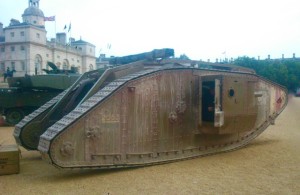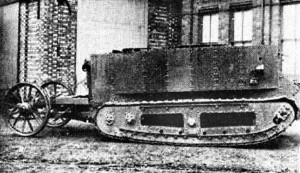Little Willie Leads to Big Cock-up
The idea of a mobile armoured vehicle capable of carrying a crew and fighting soldiers was dismissed by the Army powers that be as being impracticable.
However, in February 1915 Winston Churchill, then First Lord of the Admiralty, formed a “Landships Committee”. Its purpose was to develop an armoured fighting vehicle to convey mass numbers of troops, with a capability of breaking the deadlock that had emerged on the Western front as both sides “dug in” heralding the stalemate conditions of trench warfare. This effort was to result in a prototype vehicle being produced by the autumn of 1915 which became known as “Little Willie”, produced by William Foster & Company of Lincoln. The term “Little Willie”, possibly being an insult to the Kaiser.
Development was taking place in the utmost secrecy, even the name “Tank” was used to fool the enemy into thinking they were making water carriers to convey fresh water to the front line.
The first prototype led to the production of another grander more powerful machine named “Big Willie” which in turn led to the Mark 1 tank.During February 1916 Churchill had contacted General Haig to convince him of the worth of these landships. They were to be used as an infantry aid and any instructions were to be given and commanded in conjunction with an infantry unit. Haig though was a cavalry officer and thought like a cavalry officer. Some have said that Haig was slow to take on new technology and relied too heavily on the use of the horse. An unfair assessment in many ways as he had set up a training school in St. Vernant to train officers in the use of rapidly developing weaponry such as new trench mortars. So he was quite susceptible to the use of new equipment.
Forty nine Mark 1 tanks were eventually delivered to France. Untried and untested, they were sent for evaluation and training in preparation for unleashing a terrifying secret weapon upon the Germans.
Haig though, was under increasing political pressure at the lack of a breakthrough during the Battle of the Somme with the enormous humanitarian cost. Losses of approaching 60,000 on the first day alone followed by continuously mounting casualties and the battle now descended into a war of attrition. This present of a brand new weapon was too much of a temptation. He ordered the tanks to be deployed at a new phase of the battle to begin in the middle of September.
The Battle of Flers-Courcelette began on Friday 15th September 1916. The untried tanks were to be a central part of the operation. The great lumbering beasts, a development of an agricultural tractor with a top speed of around 4mph, powered by an engine around twelve times the size of a modern car engine and carrying a crew of eight, rumbled into the front line for the first time.
A short movie explaining the development of the tank can be seen here.
Out of the number of tanks delivered to France only about 32 made it to the assembly points. Out of these 7 failed to start and only 9 were still serviceable at the end.
As battle commenced the initial effect on the Germans was one of shock and terror. Nothing like these gigantic monsters had ever been imagined in the history of warfare, but soon the tanks’ early vulnerability became apparent. Crews had no training of any kind, they were unfamiliar with anything these machines were capable of, or the terrain they were to be introduced to. Developed in England where they were able to easily cope with ploughed fields and open farmland, they were then thrown onto the moonscape of the Western Front and found the challenge too demanding. The crews not only had to withstand the searing heat of the interior but leaking exhaust fumes filled the tank causing choking and poisoning. The enclosed space of these landships, pitching violently and crashing over the rough terrain, caused seasickness in the crews. The machine gun bullets although not penetrating the armour caused white hot metal to fly off the point of impact on the inside which would stick to the skin of the occupants. There was a lot to learn.
See the Mk1 in action here.

Replica First World War tank used in the 2011 film War Horse on display at Horseguards, London, today 15 September 2016. It normally resides in Bovington Tank Museum, Dorset
Despite having some initial success, they also failed to cause any great lasting victories and would not be used in earnest again until the Battle of Cambrai in 1917. Nevertheless, Haig was sufficiently impressed with their ability to immediately order a thousand to be delivered a.s.a.p.
Winston Churchill was less than impressed with Haig’s desperate use of the prototypes and wrote angrily. “ My poor Land Battleships have been let off prematurely on a petty scale… This priceless conception containing, if used in its integrity and on a sufficient scale, the certainty of a great and brilliant victory, was revealed to the Germans for the price of a few ruined villages.”
Find out about our connection with Dr Page and an introduction to his diary here

One Response to Little Willie Leads to Big Cock-up